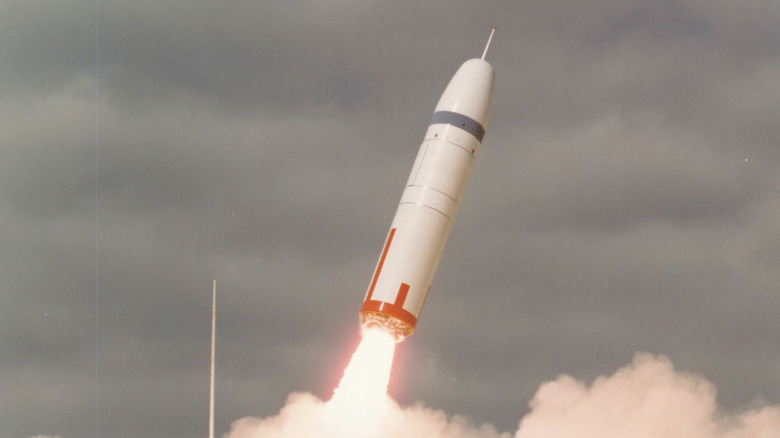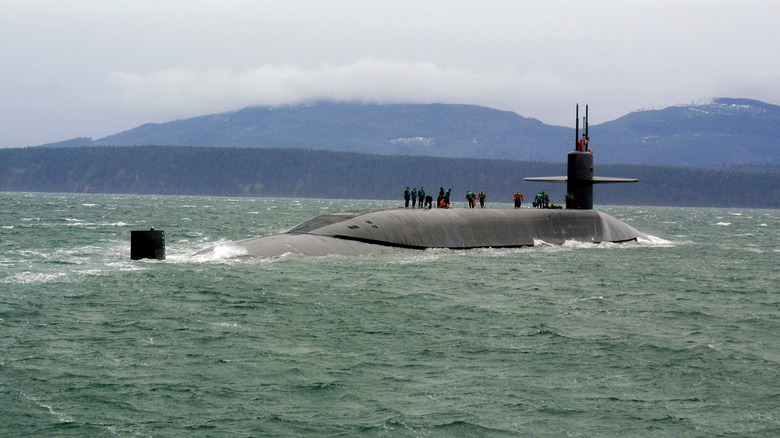Why Does The Trident Missile Have A Spike On Its Nose?
By virtue of being able to dive to the depths, submarines have an inherent escape mechanism and stealthy aspect to their operation that most other naval vessels simply can't offer. To dismiss them as sneaky support vessels focused on recon from a safe distance below the waves, though, is to undervalue the enormous and varied offensive threat submarines can pose. Sophisticated anti-aircraft missiles can allow submarines to shoot down planes, for instance, and another tool in their arsenal, the Trident missile, gives some subs the capacity to provide a significant nuclear deterrent.
Weighing in at 130,000 lbs and measuring just shy of 13.5 meters, it's an imposing sight. Its ability to carry 100-kiloton warheads underscores what monstrous weapons these missiles are. The most prominent aspect of its appearance is probably that distinctive spike on its nose. It's called an aerodynamic spike, and is a much more sophisticated component than it appears to be. It's important in limiting the effect of drag on the missile.
Whether it's a missile like the Trident or a conventional aircraft, the key to efficient flight is an aerodynamic body. Supersonic planes, such as the Concorde jet, which was ahead of its time, typically have pointed nose cones to resist drag and fly smoother at higher speeds. However, this reduces the available volume and surface area in the front of the aircraft, which can also have implications for the transfer of heat in operation. The Trident missile's spike helps make up for the limited aerodynamics of its more curved nose cone.
The complex science of an aerodynamic spike
What appears to be a simple spike is actually a sophisticated little system. The aim is, in part, to leverage the benefits of both a pointed and curved nose in one design, and the Trident family's spike can be quite effective in doing just that. The aerospike dramatically reduces drag by half , and improves the missile's performance, allowing the Trident II to reach a potential range of 6,500 nautical miles (compared to approximately 4,000 with the original Trident). This is made possible by parts of the aerospike that lock in place and help to redirect the flow of air.
As key as the spike is to the initial performance of the missile, it's quickly dispensed with. The aerospike plays its role as the missile begins to boost, and that's largely it. In the paper (the following link will download a PDF onto your device) "Development of the Trident I Aerodynamic Spike Mechanism," B. J . Richter and Mark D. Waterman explain that "after the missile leaves the atmosphere the Aerospike is jettisoned along with the nose fairing approximately 2 minutes after missile launch."
One memorable case in October 2016 saw the nose of a Trident-family missile from a U.S. test firing was washed ashore on the beach of Man-O-War Cay in the Bahamas, to be reclaimed by the Coast Guard later, according to the BBC.
The Trident missiles of the U.S. and the U.K.
Given the nature of these missiles, they are not commonly carried, and for the Royal Navy, are only equipped to specific Vanguard-class submarines. These subs are nuclear-powered as well as nuclear-armed. They're mighty submarines crewed by 132 servicepeople, and the Royal Navy reports that their sheer size is "mainly due to the need to accommodate the Trident missiles." A formidable weapon fit for nuclear deterrence, albeit one that, due to its very nature, we can fervently hope never has to be fired in response to an attack.
The United States, similarly, limits the submarines equipped with this devastating missile. It's found only on a specific class of vessel: The formidable weapon that is the Ohio class submarine. Of the 18 Ohio-class subs, 14 are armed with Tridents (four of them are armed with Tomahawk missiles instead, including USS Ohio). Each is currently equipped to hold up to 20 Trident IIs at one time.
Just like their British counterparts, they are very large vessels, through necessity of storing their hefty armaments, boasting a displacement of 16,764 tons (17,033 metric) and a length of 560 feet. Delays with the introduction of the Columbia class subs, which were originally set to replace the Ohio models over a phasing out period between 2027 and 2040, mean that it's unclear how long the latter –- Trident-equipped or otherwise –- will continue to serve in their roles.


